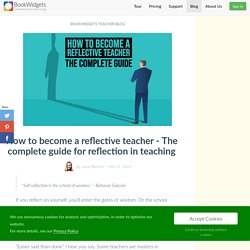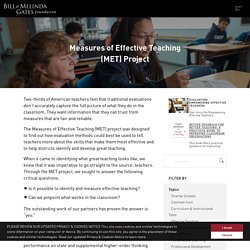

SerProf – Comunidade de professores. Estudo Inst Ayrton Senna. How to become a reflective teacher - The complete guide for reflection in teaching. “Self-reflection is the school of wisdom.” – Baltasar Gracian If you reflect on yourself, you’ll enter the gates of wisdom.

Or the school gate… Learning is what your students do in school. But not only the students are there to learn: the teacher is too. To become a better version of yourself, you must embrace feedback and criticism and reflect on your own teaching. “Easier said than done”, I hear you say. In this blog post I listed 10 ways that encourage reflective teaching. But first: What is reflective teaching? Reflective teaching means that you take a look at what you do in your classroom, and think about why you do it. Why is reflection important in teaching? Reflective teaching is an example of professional development, starting in your own classroom. The process of reflection comes with a cycle to follow: TeachSelf-assess the effect of your teaching on learningConsider new ways of teaching that can improve the quality of learningTry these ideas in practice 1. 2. 3. 4. 5. 6. 7. 8.
Tecnologia para impactar a educação. Reflective teaching: Exploring our own classroom practice. By collecting information about what goes on in our classroom, and by analysing and evaluating this information, we identify and explore our own practices and underlying beliefs. This may then lead to changes and improvements in our teaching. Reflective teaching is therefore a means of professional development which begins in our classroom. Why it is importantBeginning the process of reflection Teacher diary Peer observation Recording lessons Student feedback What to do next Think Talk Read Ask Conclusion Why it is important Many teachers already think about their teaching and talk to colleagues about it too. You might think or tell someone that "My lesson went well" or "My students didn't seem to understand" or "My students were so badly behaved today.
" However, without more time spent focussing on or discussing what has happened, we may tend to jump to conclusions about why things are happening. The first step is to gather information about what happens in the class. What are you doing? Desimone Laura M. Professional development Holko. Andragogiabrasil.com.br Ciclo de Aprendizagem de Kolb (2) Center for Education Policy Research at Harvard University. Bill Gates: Teachers need real feedback. Measures of Effective Teaching (MET) Project.
Two-thirds of American teachers feel that traditional evaluations don’t accurately capture the full picture of what they do in the classroom.

They want information that they can trust from measures that are fair and reliable. The Measures of Effective Teaching (MET) project was designed to find out how evaluation methods could best be used to tell teachers more about the skills that make them most effective and to help districts identify and develop great teaching. When it came to identifying what great teaching looks like, we knew that it was imperative to go straight to the source: teachers. Through the MET project, we sought to answer the following critical questions: Is it possible to identify and measure effective teaching? The outstanding work of our partners has proven the answer is “yes.” Based on lessons learned through the MET project, our partners identified nine guiding principles to inform the design and implementation of high-quality teacher support and evaluation systems. Avaliação qualitativa professor.
Caderno CCAP 2 Observacao. 500 Internal Server Error. Rubrics are multidimensional sets of scoring guidelines that can be used to provide consistency in evaluating student work. They spell out scoring criteria so that multiple teachers, using the same rubric for a student's essay, for example, would arrive at the same score or grade. Rubrics are used from the initiation to the completion of a student project. They provide a measurement system for specific tasks and are tailored to each project, so as the projects become more complex, so do the rubrics. Rubrics are great for students: they let students know what is expected of them, and demystify grades by clearly stating, in age-appropriate vocabulary, the expectations for a project. They also help students see that learning is about gaining specific skills (both in academic subjects and in problem-solving and life skills), and they give students the opportunity to do self-assessment to reflect on the learning process.
InsideBlackBox. Experience And Education - John Dewey. Dewey.